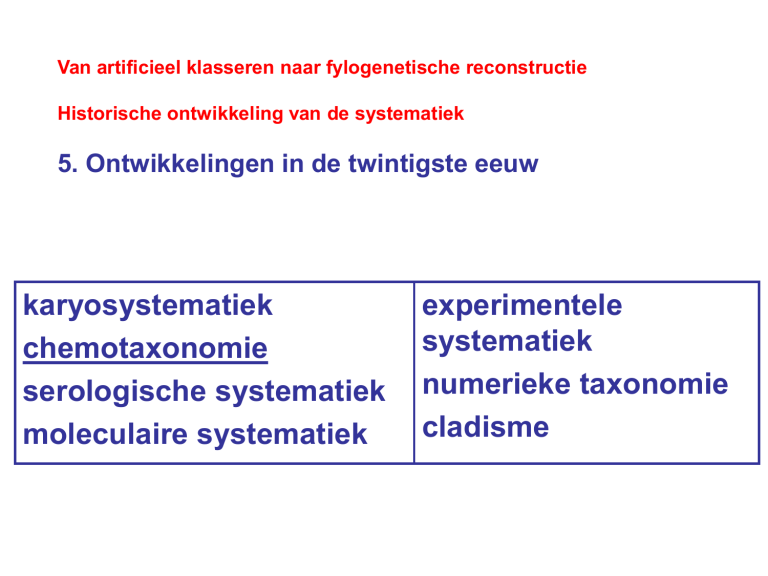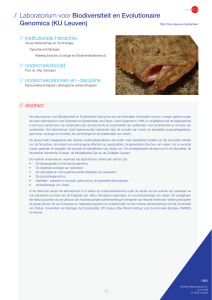
Van artificieel klasseren naar fylogenetische reconstructie
Historische ontwikkeling van de systematiek
5. Ontwikkelingen in de twintigste eeuw
karyosystematiek
chemotaxonomie
serologische systematiek
moleculaire systematiek
experimentele
systematiek
numerieke taxonomie
cladisme
Plantae quae genere conveniunt
etiam virtute conveniunt;
quae ordine naturali continentur,
etiam virtute proprius accedunt;
quaeque
classe naturali congruunt,
etiam viribus
quodammodo congruunt
Linnaeus 1751
Philosophia botanica
Taxonomische voorkeur
Brassicaceae
Asteraceae
Campanulaceae
….
Maurits Greshoff
Eerste verslag van het onderzoek naar de plantenstoffen van
Nederlandsch-Indië
Mededeelingen uit 's Lands Plantentuin 7
Batavia: Landsdrukkerij, 1890.
1909
“Strictly speaking one might
demand that every accurate
description of a genus or a new
species should be accompanied by
a short ‘chemical description’ of
the plant.”
Systematisch vergelijkend onderzoek van inhoudsstoffen
J.B. Mc Nair 1935
Angiosperm phylogeny on a chemical basis
Bulletin of the Torrey Botanical Club 62: 515
“Plants can be classified chemically in accordance with
the substances made by them.
Such a chemical classification may be compared with or
used as a supplement to morphological classification and
may be of some importance in the true natural system of
angiosperm phylogeny.”
primitief
afgeleid
grotere moleculen
glyceriden met hoger joodgetal
Na WO II
ontwikkeling van analytische technieken in de organische chemie
(chromatografie, UV en IR resonantie, NM resonantie en massaspectroscopie).
“Chemotaxonomie”
vooral secundaire metabolieten
Hegnauer R. (1962-1996)
Chemotaxonomie der Pflanzen.
Ein Ubersicht über die Verbreitung und
die systematische Bedeutung der
Pflanzenstoffe.
11 delen
(incl. Nachträge & Generalregister).
Bazel & Stuttgart, Birkhäuser.
Rolf Dahlgren (1932-1987)
chemische verdediging tegen herbivoren
secundaire metabolieten (toevalsproducten?)
worden chemische wapens
Asteraceae: veel isoprenoïde verbindingen
Bv. pyrethrolon (‘pyrethrum’
of ‘pyrethrine’)
uit Chrysanthemum roseum
& Tanacetum cinerariaefolium
Van artificieel klasseren naar fylogenetische reconstructie
Historische ontwikkeling van de systematiek
5. Ontwikkelingen in de twintigste eeuw
karyosystematiek
chemotaxonomie
serologische systematiek
moleculaire systematiek
experimentele
systematiek
numerieke taxonomie
cladisme
Serologische systematiek en aanverwante domeinen
Vergelijkend onderzoek van eiwitstructuren
- Electroforese
- Serologie
- Sequentieanalyses
Elektroforetisch onderzoek van eiwitten
Isozymstudies
Serologisch onderzoek
Werkwijze van serologisch onderzoek:
Immuno-electroforese (IEP)
Sequentie-analysen van proteïnen
Rubisco
Van artificieel klasseren naar fylogenetische reconstructie
Historische ontwikkeling van de systematiek
5. Ontwikkelingen in de twintigste eeuw
karyosystematiek
chemotaxonomie
serologische systematiek
moleculaire systematiek
experimentele
systematiek
numerieke taxonomie
cladisme
1953
Watson & Crick
1965
Zuckerkandl & Pauling
Molecules as documents of
evolutionary history
Journal of Theoretical biology 8: 357-366
Nucleïnezuren
Sequentiebepaling
Basepositie = kenmerk
Kenmerktoestanden: alternatieve basen of deleties
Alignering van de bepaalde sequenties = bepalen van homologie
-DNA replicaties met alle vier terminator nucleotiden
- gevormde fragmenten scheiden op gel
- automatische omzetting van kleurcodes gel in
letters van basen
Mutaties en deleties zijn
dan toestanden van een
(genetisch) kenmerk, d.i.
één positie in de DNAketen.
.
5S rRNA
E. coli
Secundaire
structuur
gebruikt voor
optimale alignering
cpDNA
mtDNA
nDNA
rRNA
Moleculaire klok??
collecties
morfologie
alfa-taxonomie
secundaire
stoffen
chemotaxonomie
cytotaxonomie
morfologie
chromosomen
isozymstudies
eiwitten
moleculaire
systematiek
NA sequenties
fylogeografie
biogeografie
populaties
experimentele
systematiek
cytotaxonomie
serologie












